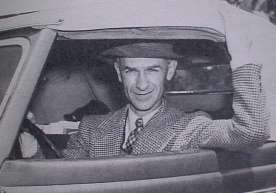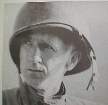Wanderlust Documented

"I have no home. My home is where my extra luggage is, and where the car is stored,
and where I happen to be getting mail this time. My home is America."
-- Ernie Pyle

"I have no home. My home is where my extra luggage is, and where the car is stored,
and where I happen to be getting mail this time. My home is America."
-- Ernie Pyle
 Friday, October 2, 1998, Dana, Indiana -
I normally don't write about dead people - they are hard to contact and they seldom have much interesting to say. I normally don't write about celebrities either. They are somewhat easier to contact, but they seldom have much interesting to say.
Friday, October 2, 1998, Dana, Indiana -
I normally don't write about dead people - they are hard to contact and they seldom have much interesting to say. I normally don't write about celebrities either. They are somewhat easier to contact, but they seldom have much interesting to say.
But I must write about Ernie Pyle, a journalist in the thirties and forties who was killed in World War II, as he was, I confess, my inspiration for this trip. Pyle is still alive today in many writers' works; watch Andy Rooney, Charles Kuralt or any "roving reporter," read Steinbeck or William Least Heat Moon and you will be affected by someone who, in some way, was affected by Pyle.
To understand why I would sell everything I own, clear my savings account, cut all ties and set off on a nineteen-month long journey, you have to go back about sixty years.
Most people today who know of Ernie Pyle, know of our country's most widely read correspondent during World War II. Few people know, however, that before the war, between 1935 and 1942, Pyle traveled the United States several times and wrote about people. He wrote very simple, effective pieces which together provide a clear impression of life in America during that period. He was called The Hoosier Vagabond, and he became the model for reporters everywhere.
As Charles Kuralt wrote in the forward to Ernie's America (Random House, 1989):
"Ernie Pyle was there first. He showed everybody else the way. He wrote plain pieces about plain people, never straining to find lofty significance in their lives, rarely analyzing them or trying to make them fit into a big picture. he was not a sociologist. he was a reporter."
 Born near Dana, Indiana in 1900, Pyle grew up envious of people of action, people like race car drivers, aviators and soldiers. He studied journalism at Indiana University, but quit shortly before graduating. He was soon working for the Washington Daily News and became their managing editor. It was here that he met and married Geraldine Siebolds.
Born near Dana, Indiana in 1900, Pyle grew up envious of people of action, people like race car drivers, aviators and soldiers. He studied journalism at Indiana University, but quit shortly before graduating. He was soon working for the Washington Daily News and became their managing editor. It was here that he met and married Geraldine Siebolds.
He became bored with working at a desk, and he tried writing articles about a trip he and Jerry took. These were very popular and he began what would become more than half a decade of touring and writing.
The great appeal of reading Pyle's columns is that he puts you right in the picture. When he writes about a Great Lakes tug boat captain, you finish the column feeling as though you just took a boat ride. When he writes about an Oklahoma land rush decades earlier, you dream of being a Sooner.
I did a lot of dreaming through Pyle's work. I had his book Home Country beside my bed and I read it each night. Then I hunted down every book with his name on it and spent the next few years getting a firsthand account of our country's twentieth century history.
I wanted to be like Pyle. Not to write like him - I couldn't hope to imitate his masterfully simple, yet eloquent style - but to explore this country, learn about its people, and write about them. Read Pyle's Home Country or Ernie's America and you will traverse the country in an open car, you will visit the dust bowl, with it's desolate plains and unforgiving winds, you will meet Greek sponge divers in Florida, shrimp canners in Mississippi, women fur trappers in Alaska and a whole world of interesting, yet "plain" people.
 Pyle's war dispatches are actually more memorable to me than his domestic ones, because of their dramatic content. I spent many hours reading about the bombing of London and the underground shelters in which the city practically lived, about D-Day and the liberation of Paris, about Tunisia, about the rugged terrain of Italy. No matter where he was, Pyle brought you right there, and he did this by writing about people.
Pyle's war dispatches are actually more memorable to me than his domestic ones, because of their dramatic content. I spent many hours reading about the bombing of London and the underground shelters in which the city practically lived, about D-Day and the liberation of Paris, about Tunisia, about the rugged terrain of Italy. No matter where he was, Pyle brought you right there, and he did this by writing about people.
AT THE FRONT LINES IN ITALY, Jan 10 (By Wireless) --
As I said, I don't wish to write like Ernie Pyle. I don't even wish to be as famous as Pyle. I just want to write about our country's people, and give them a voice above the mass media. I just want to write for our country's people, and give them stories that will enthrall them, enrich them, and help them to dream.
Photographs courtesy the Ernie Pyle State Historic Site.
Check out the
True America Features Archives
Return to our
 One of his most memorable pieces, written shortly before he was awarded the Pulitzer Prize, was about an Army Captain in Italy. I have reprinted it for you, and when you read it, you will not only have a closer understanding of what it was like to fight in that war, but you will also have a better idea of what life was like here in the states. You can imagine millions of people starting each day reading Pyle's column, reading about their sons, brothers and fathers fighting for their lives, fighting for their country.
One of his most memorable pieces, written shortly before he was awarded the Pulitzer Prize, was about an Army Captain in Italy. I have reprinted it for you, and when you read it, you will not only have a closer understanding of what it was like to fight in that war, but you will also have a better idea of what life was like here in the states. You can imagine millions of people starting each day reading Pyle's column, reading about their sons, brothers and fathers fighting for their lives, fighting for their country.
MAIN page